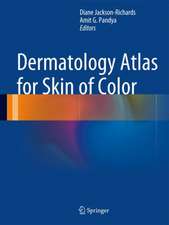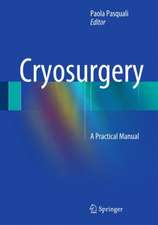Cell and Tissue Culture Models in Dermatological Research
Editat de August Bernd, Jürgen Bereiter-Hahn, Frank Hevert, H. Holzmannen Limba Engleză Paperback – 15 dec 2011
Preț: 720.47 lei
Preț vechi: 758.38 lei
-5% Nou
Puncte Express: 1081
Preț estimativ în valută:
137.88€ • 149.72$ • 115.82£
137.88€ • 149.72$ • 115.82£
Carte tipărită la comandă
Livrare economică 22 aprilie-06 mai
Preluare comenzi: 021 569.72.76
Specificații
ISBN-13: 9783642778193
ISBN-10: 3642778194
Pagini: 384
Ilustrații: XV, 363 p.
Dimensiuni: 155 x 235 x 20 mm
Greutate: 0.54 kg
Ediția:Softcover reprint of the original 1st ed. 1993
Editura: Springer Berlin, Heidelberg
Colecția Springer
Locul publicării:Berlin, Heidelberg, Germany
ISBN-10: 3642778194
Pagini: 384
Ilustrații: XV, 363 p.
Dimensiuni: 155 x 235 x 20 mm
Greutate: 0.54 kg
Ediția:Softcover reprint of the original 1st ed. 1993
Editura: Springer Berlin, Heidelberg
Colecția Springer
Locul publicării:Berlin, Heidelberg, Germany
Public țintă
ResearchDescriere
In this volume the impact of cell culture models ondermatological research is discussed by scientists frommedicine, physiology, biology, pharmacology,and pharmacy.The book includes the following topics: orthology andpathology of the skin, differentiation of keratinocytes andfibroblasts, problems of the cultivation of melanocytes,biochemistry of pigment metabolism, models for wound healingand tissue renewal, fibroblast function and metabolism ofcollagen, models for the investigation of ageing as well asmodels for pharmacological and toxicologial tests.Thus, a wide arch is spanned, from basic problems withcultivation and characterization of cell cultures toexamples of application. Dermatologists as well as cellbiologists will benefit from this publication.
Cuprins
1. Models in Orthology and Pathology.- Development of a Cell Culture System to Detect and Analyze Pathogenicity of Autoantibodies Directed to Nuclear Antigens.- Cell Cultures of Fetal Human Skin Are Suitable Models for the Investigation of Mitogenic Activity in Psoriasis Sera.- Influence of Human Sera on the Adherence of Candida albicans to Buccal and Intestinal Cells in Culture.- Modulation of 1,25-Dihydroxyvitamin D3 Receptor (VDR) Expression in HaCaT Keratinocytes.- Aminopeptidases of Human Skin — a Survey of Enzyme Activities in Extracts from Skin and Cultured Fibroblasts.- Determination of Cell Counts and Cell Proliferation by the Fluorochromes Hoechst 33342 or Hoechst 33258.- Volume Determination of Adhering Cells in Culture by Means of Acoustic Interferometry.- Effects of Uremic Compounds on Cultured Myocytes: a Model for Uremic Myocardiopathy.- Cultivation of Trophoblast Tissue of Human Intrauterine and Ectopic Pregnancies and Treatment with Methotrexate.- 2. Models in Differentiation of Keratinocytes.- Mechanical Stimulation Enhances Human Keratinocyte Differentiation in Culture: Induction of Cytokeratin 9 Synthesis.- N-Alkanes in Cultured Normal Human Keratinocytes.- Influence of Retinoids on the Keratin Profile in Normal and Spontaneously Transformed Human Keratinocytes.- Cytological Characterization of Three-dimensional, Graftable Human Keratinocytes Cultures.- Fluorometric Measurement of Suprabasal Cytokeratins and DNA of Human Keratinocytes Cultivated in Microtiter Plates.- 3. Models in Pigmentation.- Biochemistry of Mammalian Pigmentation: Enzymatic Regulation of Melanogenesis.- Cultured Epidermal Melanocytes from Patients with Neurofibromatosis 1 (Recklinghausen’s Disease): a Cell Culture Model for Neurofibromatosis 1.- Pigmentation in Cultures of Human Melanocytes.- 4. Models in Wound Healing.- Re-epithelialization of Incision and Burn Wounds in Culture.- Primary Culture of Bilayered Epidermal Cell Sheets.- Plasminogen Activator Contained in Secretions of a Keratinocyte Cell Line and in the Fluid of Intraepidermal Pemphigus vulgaris Blisters Is Activated by Sodium dodecyl sulfate.- Are Rat Granulation Tissue Fibroblasts Regulated by Cytokines in the Same Manner as Skin Fibroblasts?.- Cultured Allografts for Wound Conditioning and Enhanced Epithelialization of Chronic Venous Ulcers.- Collagen Type-I Is Chemoattractive for the Human Keratinocyte Cell Line (HaCaT).- 5. Models in Fibroblast Function and Collagen Metabolism.- The Molecular Biology of the Terminal Differentiation of Dermal Fibroblasts in the Fibroblast Stem Cell System In Vivo and In Vitro.- Cytokine-dependent Regulation of Human Dermal Fibroblasts Cultured in a Three-dimensional Collagen-Gel.- Investigation of Components of the Dermal-Epidermal Junction Zone In Vitro: Effect of Transforming Growth Factor-beta on Collagen VII Expression.- The Influence of Retinoids on Chemotaxis and Connective Tissue Synthesis of Fibroblasts.- 6. Models in Skin Ageing.- In Vitro Studies of Fibroblast Aging: Growth Factors, Collagen and Glycosaminoglycan Synthesis — a Review.- Terminal Differentiation, Aging, Apoptosis, or Transformation of the WI-38 Fibroblasts in the Fibroblast Stem Cell System In Vitro.- Differential Gene Expression, Protein Synthesis, and Degradation in Aging Fibroblasts.- Age Differences in Human Skin Collagen.- Influence of Cell Density of Energy Metabolism and the Actin Skeleton of Different Cell Types.- 7. Models in Skin Pharmacology and Toxicology.- (+)-Aeroplysinin-l: an Inhibitor or Intrinsic Protein Tyrosine Kinase Activity of EGF-Receptor-Kinase Complex.- In Vitro Cultivation of Human Dermal Microvascular Endothelial Cells as a Model for the Dermatopharmacology.- Effect of Nicotine on the Differentiation of Human Keratinocytes In Vitro.- A New In Vitro Test System and Phototoxicological Studies on Cell Cultures Based on the Melamine Substrate Foil.- In Vitro Assays for Evaluation of the Effects of 8-Methoxypsoralen and UV Irradiation of Human Lymphocytes and Granulocytes.- Comparative Cytotoxicity Test with Human Keratinocytes, HaCaT Cells, and Skin Fibroblasts to Investigate Skin-Irritating Substances.- SDS-Induced Activation of the Cutaneous Plasminogen Activator System: A Molecular Pathway Possibly Involved in SDS-Induced Skin Irritation.












